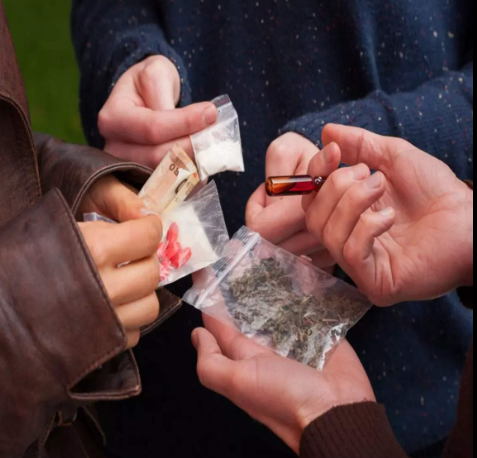Annual survey data indicate which drugs and other substances are most regularly used by youngsters nowadays. Teen drug use, by the numbers
Many parents have long been concerned about their children’s drug use.
Data demonstrates why such concerns these days extend beyond worrying about a youngster perhaps puffing on pot, with the rise of fentanyl fueling record-high fatal overdose totals in the United States and research pointing to the synthetic opioid’s lethal influence on youth.
However, there is some good news: despite the educational and societal disruptions created by the COVID-19 epidemic, illicit drug consumption among American teenagers has remained mostly stable at lower levels reached in 2021. According to estimates from the most current iteration of the annual Monitoring the Future survey, the proportion of 10th- and 12th-grade students who have never used alcohol, marijuana, or nicotine has increased significantly to around 54% and 38%, respectively.
Also read-Does It Matter What You Eat Or Drink Before Going To Bed

Teen Drug Use
Since 1975, the Monitoring the Future survey has offered a national snapshot of substance use among American adolescents and teens. The most recent drug use statistics were derived from surveys of over 22,000 eighth, tenth, and twelfth-grade students from 235 public and private schools.
Here are some of the project’s most prominent teen drug use findings.

Teen Drug Use
What drugs and substances do teens use the most?
Alcohol, marijuana, and nicotine through vaping remained the most commonly used substances among teenagers in 2023, albeit at significantly lower levels than before the epidemic.
In 2023, approximately 29% of 12th-graders, 18% of 10th-graders, and 8% of 8th-graders had used marijuana during the previous year, a rate that had been largely stable since 2021. The combined lifetime consumption of marijuana and hashish for all three grades was 23%. Marijuana use has decreased since the epidemic began, marking the first significant fall in prevalence in almost a decade, according to academics.

Teen Drug Use
Other Drug and Substance Use among Teens.
According to the most recent Monitoring the Future survey data, lifetime cigarette usage “trended slightly downward in all three grades” in 2023. Lifetime use throughout all grade levels was around 10%.
“Overall, cigarette prevalence in 2023 (was) at or near the lowest ever recorded by the survey since the start of the survey in 1975,” according to the paper.

Teen Drug Use
Other substances have the following lifetime incidence rates across all three grade levels:
- Cocaine – 1.1%
- Methamphetamine: 0.5%
- Heroin – 0.5%
- Hallucinogens (including LSD and psilocybin): 4%

Teen Drug Use
Select substances have the following past-year prevalence rates among 12th graders:
- OxyContin – 0.6%
- Vicodin – 0.6%
- Ecstasy (MDMA) – 0.7%
- Ketamine – 1%
- Any prescription drug (without doctor’s orders) – 4.1%

Teen Drug Use
Digging Into Delta-8, aka ‘Diet Weed’
In 2023, the poll included a new question about 12th-grade students’ use of delta-8 THC, a form of the major psychoactive ingredient in cannabis known as “diet weed.” Delta-8 is legal at the federal level due to a legislative loophole, but not in all states. It is now available in places such as petrol stations, smoke shops, and convenience stores. It comes in a variety of forms, such as gummy sweets and flavored vaping equipment.
MTF anticipates that more than 11% of 12th-grade pupils used delta-8 in the previous 12 months in 2023. The prevalence of delta-8 use was found to be higher among youths who lived in states that had not legalized recreational marijuana for adults.

Teen Drug Use
Increase in legal use of ADHD medications
The percentage of 12th-grade students who had ever legally used medicines to treat attention-deficit/hyperactivity disorder fell slightly in 2023 to 14.3%, after rising from 11% in 2021 to a peak of 14.6% in 2022, the biggest single-year increase on record.
The lifetime prevalence among eighth-grade children fell from 12% in 2022 to 10% in 2023, while the percentage among tenth-grade students stayed close to 11% in both 2022 and 2023.
“It is possible that the need for treatment of ADHD increased during the pandemic due to adolescents experiencing more stress during the pandemic,” according to the MTF report. “Another possibility is that sheltering at home during the pandemic may have made any attention issues of adolescents more salient to their parents.”

Illicit prescription drug use decreases.
The use of any prescription drug without a doctor’s prescription among 12th-graders remained stable at the low level attained in 2021, shortly after the pandemic began.
In 2023, 4% of 12th-grade pupils used prescription medications in the previous year, compared to 5% in 2022 and 7.5% in 2020. The lifetime prevalence in 2023 was 8.5%, a decrease from 14% in 2020.

Also read:Priyanka Chopra’s Bob-Cut Hairstyle Memories Us ‘Meghna Mathur’ In Her Film ‘Fashion’
images source: Google
Disclaimer: The opinions and suggestions expressed in this article are solely those of the individual analysts. These are not the opinions of HNN. For more, please consult with your doctor



































